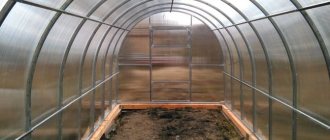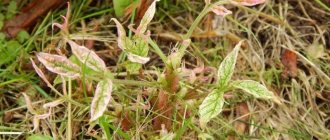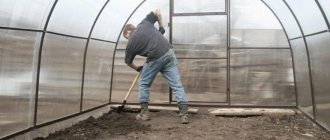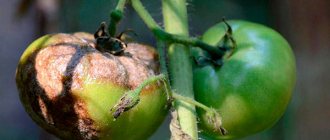An important measure for caring for tomatoes in a greenhouse and open ground is spraying the crop with nutrient solutions. Foliar feeding of tomatoes helps in treating seedlings from infectious and fungal diseases, enhances plant vegetation, and contributes to obtaining a large and high-quality harvest. In addition, foliar sprays can quickly revive plants in the event of an acute shortage of micronutrients.
How to protect tomatoes from diseases and pests
Even if tomato seeds have been pre-treated against most diseases, this does not mean that tomato seedlings or bushes will remain strong and healthy throughout the season.
Tomatoes can be affected by diseases caused by fungi, bacteria or viruses. This happens most often because vegetable growers do not follow the rules for caring for seedlings and adult plants and constantly plant tomatoes in the same places without following the rules of crop rotation. Also, much depends on the location of the beds, as well as on weather conditions in a particular summer season. The most common diseases that can affect tomatoes are fungal diseases.
Why is spraying necessary?
Any vegetable crop absorbs substances not only through the root system, but also through the foliage. If we talk only about tomatoes, then this ability is even more developed in them than in other vegetables. Plants immediately respond to any unfavorable conditions - temperature changes and micronutrient deficiency. High humidity causes the activation of fungal diseases. In hot weather, root feeding can lead to burns of the underground part of the plant by chemical components.
The soil, even well fertilized before planting, is not able to guarantee nutrition for fruiting bushes until the middle of the season. Spraying is a type of emergency help for plants, because stimulants, fungicides and fertilizers immediately enter the cells, bypassing the stage of absorption of substances from the soil. If the traditional, root type of feeding requires about 10 days, then the preparations applied to the foliage begin to “work” within the first two hours.
Spraying is a necessity at any stage of crop development. Weakened seedlings readily absorb the element, so they quickly become strong and healthy. Equally important is foliar feeding during the flowering and fruiting period. In this case, the plants will be provided with complete, high-quality nutrition, and the owners will be provided with the absence of nitrates in fruits and vegetables.
The ideal option for tomatoes that do not look very healthy and do not develop very well is alternating root and foliar feeding. In this case, the second will be an express aid to the plants, and then the necessary substances will be absorbed by the root system. An important condition is to spray foliage in cloudy weather, or in the evening when sun activity decreases. Otherwise, the leaves will get burned due to the magnifying drops.
What to spray after rain
If you need to restore tomato seedlings after rain, then effectively use the following means:
- Milk serum . You need to take 1-2 liters of raw material and dilute it in 10 liters of water.
- Ash solution . Dissolve 300 g of ash in 0.5 liters of water. Place on the stove and simmer for 20 minutes. Then add 20 g of soap. Stir and combine with 10 liters of water.
- Garlic infusion . Take 200 g of cloves, finely chop. Add 10 liters of water. Leave for 2 days.
- Iodine solution . Dissolve 20 drops of iodine in 10 liters of water.
- Potassium permanganate solution . Take 10 liters of water and 1 g of substance.
- Trichopolum . This is a non-toxic drug that has an antifungal effect. It is necessary to dissolve 10 tablets of the drug in 10 liters of water. Before use, add 200 g of milk to the solution.
If you liked the article, please share it
Previously on the topic:
Share
Folk recipes
They are used to prevent diseases and to ensure the growth of tomato ovaries.
Boric acid
Boric acid is effective in the fight against late blight, enhances flowering, and promotes the formation of ovaries. To prepare an “anti-phytophthora” solution, ½ teaspoon (without top) of powder is first dissolved in a glass of hot liquid, then this concentrate is added to a container with 10 liters of water. To prevent the ovaries from shedding, 1 g of boric acid is stirred in 1 liter of hot water, and this product is used after cooling.
Calcium chloride
Calcium chloride is used for the prevention and treatment of late blight at the initial stage of the disease. This substance improves the growth of tomatoes and has a positive effect on their productivity. Calcium chloride is part of complex plant treatment along with fungicides and copper preparations. Pharmacy ampoules are used as follows: 10 pieces are diluted in 10 liters of water, then 300 g of wood ash are added, as well as 40 g of grated laundry soap. The last component ensures that the solution sticks to the tomato leaves.
Superphosphate
This complex fertilizer can provide tomatoes with ideal, balanced nutrition. It contains nitrogen (8-17%), sulfur (5-10%) and phosphorus (25-55%). The proportions depend on the purpose, type of vegetable crop and fertilizer manufacturer.
Spraying plants with a superphosphate solution can be started at any time: such nutrition is equally beneficial for both seedlings and adult bushes. For the former, fertilizer will improve seed germination, stimulate the development of a healthy root system and guarantee rapid growth of green mass. The complex is also a benefit for adult plants: it will allow you to get a large harvest and improve the shape, size and color of the fruit.
Superphosphate is used for both types of feeding. To spray tomatoes, use the following recipe: stir one tablespoon of superphosphate in a liter of hot water. After preparation, the solution is kept for 24 hours, and only then the above-ground parts of the plants are treated with it.
Other effective folk remedies
This small list can and should be continued.
- Rotted straw and urea. This remedy will help cope with late blight. One kilogram of straw is poured into 10 liters of water, then 2 tablespoons of urea are added. The “medicine” is left for several days (3-4), then filtered and irrigated the plants. This infusion can be used for prevention.
- Ash. This powder is used as root and foliar feeding of tomatoes. In this case, they also make an infusion. 200-300 g of ash are diluted in 10 liters of warm water, then the container is left alone for 2 weeks, then the liquid is strained and used.
- Milk and urea. This is an unusual “duet” that is used to rid plants of tomato mosaics. Milk (only natural, not pasteurized) is diluted with water (1:10), then a teaspoon of urea is added.
- Iodine. To prepare the preparation for spraying, 2 ml of liquid is stirred in 10 liters of water. The solution is intended to combat late blight and for prevention.
- Hydrogen peroxide is used to disinfect foliage, and it can also improve oxygen access to tissues. 30 ml of peroxide is stirred in 2 liters of water.
- Calcium nitrate. This fertilizer is used to treat blossom end rot. One tablespoon of saltpeter is stirred in 10 liters of water.
- Potassium permanganate. To spray tomatoes, use a weak solution of potassium permanganate. The soil is treated with the same product.
- Zelenka. This liquid is used to protect against late blight. 3 ml of brilliant green is dissolved in 10 liters of water.
- Furacilin is another remedy for the prevention and treatment of late blight. 10 tablets are dissolved in 10 liters of water.
To improve nutrition and protect tomatoes from pests and various pathologies, a large and varied range of “common-ordinary” products are used. Plants are sprayed with diluted yeast (100 g per 10 l), solutions with soda (3 tbsp per 10 l), salt (250 g per 10 l), vinegar (100 mm per 10 l), diluted kefir or whey ( 1 l per 9 l).
Signs of micronutrient deficiency
The deficiency of one or more elements can almost always be detected. A deficiency of a specific substance is accompanied by visible signs. These symptoms are most easily noticed at the stage of green mass formation and during the fruiting period.
- Nitrogen. Its deficiency provokes yellowing of the leaves of the lower tier at the edges, and their subsequent falling off. The veins on the back side of the plates become red-blue.
- Bor. A deficiency of this microelement causes the leaves to curl and the flowers to fall off before they even have time to form ovaries.
- Iron. With its deficiency, the symptoms are the same as with a lack of nitrogen (yellowing), but in this case the tops of the plants change color.
- Phosphorus. When it is deficient, the aboveground part of the plant becomes greenish-blue, the leaves become deformed, the stem becomes brittle, and the roots wither.
- Zinc. Its deficiency is the reason for the appearance of gray brown spots on plants, which turn into necrosis. The shape of the plates changes - they curl up.
- Potassium, magnesium. Here the consequence is the same: the leaves curl and then turn yellow at the edges of the plates.
Moderation is needed in everything. If we talk about plants, then not only a deficiency, but also an excess amount of microelements is dangerous for them. For example, preparations containing nitrogen in large doses lead to increased growth of tops, which prevents the development of fruits. The latter can accumulate “extra” nitrates in the pulp.
The most effective drugs
Traditional recipes can help, but they can also be completely powerless. Therefore, in any serious situation, it is better to look for other options for saving plants. As a rule, such preparations are intended for feeding tomatoes, or to combat certain types of threats.
Prevention
Such treatment of tomatoes growing on the site should be constant during the period lasting from the cultivation of seedlings to the beginning of the peak fruiting of the plants. At this time, maximum attention is paid to the above-ground parts of the bushes - they carefully monitor the slightest changes in their condition. Sometimes even skipping one of the sprays weakens the plant, so it either becomes “prey” for pests or is affected by disease. Moreover, regardless of whether the tomato lives in greenhouse conditions, or, conversely, “vegetates” in the open ground. Now about the necessary drugs.
- Abiga Peak. Tomato seedlings are treated with this product a week before moving to permanent residence. It is also used for spraying throughout the entire period before flowering begins.
- Aktara. This systemic insecticide begins to be used a week after planting tomatoes in a permanent place.
- Ridomil Gold (with Fitosporin) or Oxyx are preparations used for spraying after tomatoes have flowered. During the period of fruit formation (ripening), Fitosporin or Fufanon are added to them (an alternative is Abiga Peak).
- Abiga Peak, Ridomil Gold (Oxychom), Fitosporin. The bushes are sprayed with a mixture of these preparations 3 weeks before harvest.
- Abiga Peak, Fitosporin and Lepidocide are products used when the last tomato harvest is ripening.
At the stage of mass flowering, a special preparation is used - Tomaton, which contains plant hormones. To protect against fungal infections, plants cultivated in open ground are treated with Epin-extra. Popular biological fungicides include Gamair, Trichodermin, Fitolavin-300, as well as the two-component Previkur Energy.
Plant treatment
In the absence of regular spraying and other preventive measures, the risk of damage to the nightshade crop greatly increases. In order for such treatment to be as effective as possible, it is necessary to correctly determine the pathology, since all drugs have their own indications.
How and with what to spray tomatoes affected by a particular disease?
- Oxychome is effective against late blight. Two tablets are diluted in 10 liters of water.
- Barrier and Barrier are drugs that can save bushes from cladosporiosis.
- Novosil or Polyram is used for plants affected by anthracnose.
- Copper humate. It is used to treat the aboveground part of tomatoes during bacteriosis.
- Use a barrier or Fundazol if fomoz is detected.
Since there are a lot of tomato diseases, new fungicidal preparations are constantly appearing, the creation of which took into account the immunity of the crops.
Pest protection
There are many enemies and “fans” of tomatoes, so not a single gardener can do without special protection from them. How and with what to spray tomatoes if they are attacked by the “enemy”? Since some types of pests are very rare, it is better to use drugs designed to combat the most common “tomato” insects.
- Actellik. The drug will be effective if the treatment is planned to be carried out at the first signs of the appearance of whiteflies.
- Actellik and Fitoverm will help if the bushes are “chosen” by spider mites.
- Fitoverm will make it possible to rid tomatoes of root-knot nematodes.
If we talk not only about protection from pests, but also about accelerating plant growth and improving survival rate, then in this case biological insecticides are used. Examples - Nematophagin-Micopro, Bitoxibacillin, Lepidotsid, Dachanik. Such products can be used in combination, but before using any of them, you must read the recommendations of the drug manufacturers.
How and with what to spray tomatoes? The first part of the question is not difficult to understand, and a large range of products will allow you to choose the most effective drugs. However, when choosing a fertilizer, you need to take into account the characteristics of the soil, because an excess of nutrients is just as harmful as their deficiency.
Stimulation
Inside each plant there is a certain set of phytohormones that are responsible for growth, flowering or fruit formation. Based on these natural elements, scientists have developed artificial analogues. Biological products in small doses have a beneficial effect on tomatoes. Of course, they will not replace nutritional supplements, but they will help the crop cope with stressful situations.
Epin
An excellent tool for adapting to unfavorable living conditions - sunburn, cold and heat. The advantage of the substance is that it is absolutely non-toxic for people and animals; there is no “habit” of accumulation in tissues or fruits. For use, it is enough to dilute 10 drops of the drug in a liter jar of water. Since the active elements decompose under ultraviolet light, all work is carried out after sunset.
The procedure is best done in the evening
"Epin" cannot eliminate the lack of nitrogen, magnesium or potassium, but it will minimize the consequences for the plant. Thanks to the stimulant, seedlings are planted without complications and mass death of seedlings. You should not get carried away with the drug, otherwise the overfed crops will stop producing natural hormones on their own.
Zircon
An excellent activator of growth, root formation and flowering, increases resistance to dangerous diseases such as late blight and powdery mildew. Unlike Epin, this product accumulates in tissues, so the dose and number of sprays must be precisely dosed. Three drops of the medicine are added to a liter of slightly warm water, after which the plants are treated.
Due to the fact that important elements are activated by sunlight, procedures are carried out in the first half of the day. “Zircon” is gradually removed from tomatoes, after which the event can be repeated again. We do not recommend using several hormonal medications at the same time.
Work schedule for tomato protection
| Timing of protective measures | Harmful object | Drugs and consumption rates | Notes |
| Perennial dicotyledonous and cereal weeds | Hurricane Forte 500 SL 40 ml per 2–3 liters of water per 1 hectare | Preparing areas for sowing seeds or planting tomato seedlings in the fall after harvesting the predecessor crop | |
| Annual dicotyledonous and cereal weeds | Dual Gold 960 EC 16 ml per 5 liters of water per 1 hundred square meters | Spraying the soil before planting seedlings | |
| Soil pests: (larvae of the May beetle, wireworm), Colorado potato beetle, aphid | Aktara 25 WG 1.4 g per 0.7 l of water (200 plants) | Soaking the roots of seedlings before planting in the ground in a 0.2 percent suspension of the drug at a temperature of 18-23 ° C for 2 hours | |
| Pests: Colorado potato beetle, aphid Diseases: late blight, alternaria blight, macrosporiosis | Quadris 250 SC 6 ml per 5 liters of water per 1 sq.m. Aktara 25 WG 1.4 g or Enzhio 247 SC 3.6 ml per 10 liters of water per 2 sq.m. | Treatment 8-10 days after planting seedlings. Insecticides are used if the roots of the seedlings are not soaked | |
| Annual and perennial cereal weeds | Fusilade Forte 150 EC 20 ml per 2–3 liters of water per 1 hundred square meters | With active growth of cereal weeds | |
| Pests: cutworm larvae, aphids Diseases: late blight, alternaria | Enzhio 247 SC 3.6 ml per 10 l of water Ridomil Gold MC 68 WG 50 g per 10 l of water | Tank mixture | |
| Pests: cutworms Diseases: late blight, alternaria | Match 050 EC 8 ml per 10 liters of water Ridomil Gold MC 68 WG 50 g per 10 liters of water If Alternaria develops strongly, treat it with fungicide Skor 250 EC 5 ml per 5 liters of water | Tank mixture. Treatment 10-14 days after the previous one. Repeated treatment with Ridomil Gold after 8-10 days in unfavorable weather conditions | |
| Diseases: late blight, alternaria | Revus Top 500 SC 12 ml per 10 l of water | ||
| Pests: cutworms Diseases: late blight, alternaria, macrosporiosis | Match 050 EC 8 ml per 10 l of water Revus Top 500 SC 12 ml per 10 l of water | Tank mixture | |
| Diseases: late blight, alternaria, macrosporiosis | Quadris 250 SC 6 ml per 5 liters of water per 1 hundred square meters | The waiting period from spraying to harvesting is 5 days |
You may also find the following materials useful:
- Spider mites on currants: how to get rid of them, how to treat them, the most effective remedies
- Tar from garden and garden pests: eleven options for using a natural remedy
- How to feed carrots in open ground: what to fertilize, the best methods and means
- How to get rid of slugs on your property: the most effective methods and means
- Feeding peppers during flowering and fruiting: what to feed, the best means
Means Signor Tomato
Fertilizers can stimulate growth and fruiting
The product is not inferior in effectiveness to the previous one. Signor Tomato is a complex drug with systemic contact action. Among the advantages of this fertilizer are:
- increasing the vegetative mass to the required level;
- reducing the likelihood of infection by viral and fungal diseases;
- increasing the drought resistance and heat resistance of the plant;
- improvement of yield indicators;
- acceleration of fruit ripening.
To treat tomatoes with this fertilizer, 30 ml of the drug is diluted in 5 liters of clean water. This amount of solution will be enough to treat 1 hectare of land. Spraying is carried out when 15% of ripened fruits have already appeared on the bush.
Tatyana Orlova (candidate of agricultural sciences):
Only insecticides or fungicides are systemic or contact-intestinal. The former are integrated into the cell structure and remain in the organs and tissues of the plant for a relatively long time (2-3 weeks) and remain poisonous or simply inedible for insect pests or pathogens. Contact intestinal pathogens cause the death of pathogens when they come in direct contact with them.
Preventive measures
To prevent the spread of late blight spores and protect tomatoes, it is recommended to follow the following preventive measures:
- Autumn treatment of greenhouses with sulfur bombs.
- Spring disinfection of soil with copper sulfate.
- Control nitrogen levels in the soil and restore the natural balance using peat and coarse sand.
- Moderate watering.
- Frequent loosening of the soil.
- Stepping and thinning.
- Mulching the soil with sawdust and pine needles.
- Ventilation of greenhouses.
- Covering beds in open ground with spunbond (agrofibre made from environmentally friendly polypropylene).
- Timely application of potassium-phosphorus fertilizers.
- Compliance with the principles of crop rotation (the best predecessors of tomatoes are white and cauliflower, zucchini, legumes, pumpkin, onions).
- Soaking seeds collected by hand in a solution of “Fitosporin” or “Phytodoctor”.
- Treating holes for seedlings with boiling water or a hot solution of potassium permanganate.
Mosaic
Mosaic - with this viral disease, a marble pattern appears on the leaves, then they wrinkle. Already formed fruits become smaller.
The source of the disease is seeds, contaminated soil cover and the remains of diseased shoots. Mosaic is carried by cicadas and thrips. It cannot be cured, so the plants are simply removed.
Methods of fertilizing
Fertilizing the soil is carried out using 2 main methods:
- Dissolved fertilizers are applied directly to the roots. The manipulation is quite convenient and simple. It is worth considering that the efficiency of this method of irrigation is somewhat reduced, since most of the solution penetrates into the soil and goes inside. It turns out that some part of the fertilizer does not directly enter the root system of tomatoes.
- Another method is spraying. It is done on the ground around the bushes of the plant, along the stems and leaves. In this option, the main part of the nutrients is gradually absorbed and reaches the roots in larger quantities.
Important! Before using water for diluting fertilizers, it must settle.
This is done so that chlorine disintegrates under the influence of the sun, and all the harmful impurities contained in tap water precipitate.
Gardeners often advise using rain or melt water. One “but” – it is not always possible to obtain or extract it.
Before using any of the remedies listed in the article to improve the condition of tomato bushes, it is important to make sure that the tomatoes are not affected by pests or diseases.
After all, the ovary is often missing or falls off when the bush is infected with wireworms, whiteflies, May beetles, mole crickets or cutworms.
Excessive moisture levels lead to tomato bushes becoming infected with a fungal infection. As a result, the plant dies completely or only part is affected. Therefore, it is important to minimize all negative aspects, and then carry out fertilizing and spraying.
Have a good tomato harvest in the new season!
Farmers' advice
We recommend using the recommendations of experienced farmers to combat late blight:
- Provide dry air and moderate watering in the greenhouse.
- After planting seedlings, mulch the soil with sawdust, pine needles or peat.
- Keep vents and doors open for pass-through design.
- Water the bushes strictly to the roots.
- Do not allow condensation to accumulate on the walls of the greenhouse.
- Water the bushes in the evening with warm, settled water.
- Do not water in cloudy, damp weather.
- Choose the most late blight-resistant hybrids and varieties.
- Pay attention to tomatoes with early ripening and fruit yield. They simply do not have time to become infected with late blight.
- Immediately remove and burn affected stems, leaves and fruits, and disinfect the tools.
- Monitor the level of nitrogen in the soil. Its excess promotes infection.
- Try not to plant tomatoes in the same place every year. Areas where potatoes, peppers and eggplants were grown are not suitable for planting.
- To replant tomatoes in a greenhouse, sow beans, peas, and lentils in the fall.
Prevention measures
To reduce the likelihood of infestation with black aphids or other varieties, preventive measures are necessary.
- Pay attention to large concentrations of garden ants in your garden or vegetable garden. Their anthills may contain aphid eggs. To effectively combat these pests, it is recommended to first remove the ants from your area.
- Even in the early stages of infection, take comprehensive measures. A female can lay more than 2 thousand eggs in a month, which leads to rapid proliferation of the colony. Even at the initial stage of infection, it is better to use several control methods.
- Plant repellent plants and attract ladybugs to your area.
The danger of late blight
Phytophthora infestans is a fungus that reproduces by zoospores. Translated from Latin it means “destroying plants.” The name speaks for itself; the fungus completely destroys the plant tissue it enters. Causes a disease - late blight. Most often, nightshades (potatoes, eggplants, peppers, tomatoes) are infected.
The spores spread quickly in high humidity conditions and can cause irreparable damage to farms. Signs of late blight appear in early July. During this period, the most favorable conditions for the growth of the fungus develop: high air humidity (above 75%), temperature fluctuations day and night, abundant morning dew.
Reference . In dry and hot weather, the development of the disease stops, and the spores themselves quickly die in the heat.
Signs of late blight damage to tomatoes:
- dark brown spots on leaves, stems and fruits;
- white fluffy coating on the back of the leaves;
- deformation of tomatoes.
The photo shows tomato leaves affected by late blight.
Alternaria blight
Alternaria blight (dry spotting) - manifests itself in the form of zonal spots on the leaves, and soon on the stems. The fruits are affected by spots near the stalks.
The disease develops at temperatures from +25 to +30 degrees, with little humidity. Treatment with fungicidal agents is appropriate here.
Symptoms of aphids
Recognizing aphids on tomatoes is quite simple. These insects can be colored in shades of black, white, green and brown.
Interesting! The plant juice contains alkaloids that repel aphids. However, in the absence of crops more attractive to the pest, it settles on tomatoes.
You can suspect the appearance of aphids based on several signs:
- The appearance of curled leaves. They often appear yellowed.
- Slowing growth and development of culture.
- Deformation and fall of the ovaries.
- Stopping the growth of the fetus and its rotting.
- The appearance of sticky mucus (honeydew) on the leaves of the plant.
- Active interest of ants in culture.
The pest appears most often on young shoots and leaves. At the initial stage of infection, you can get rid of aphids on tomatoes using a mechanical method. When the spread is severe, the use of comprehensive measures is effective.
General processing rules
The basic rules for processing tomato bushes for ovary are simple:
- Do not spray bushes on a hot or windy day;
- The water should be at room temperature or slightly warmer;
- When treating plants, the solution must fall exactly on the brush. Spraying on the leaves will not have any effect;
- Phytostimulants should not be combined with other drugs or combined with each other;
- To increase the ovary, it is recommended to spray the plants three times per season. The interval between the first and second treatment should not exceed a week.
Chemicals are not phytotoxic. However, when working with them, you should use gloves, and in large areas, protect your respiratory system.
When and what manipulations are performed?
All manipulations have a clear distinction depending on the calendar period:
The months of August and September are characterized by cleaning work on plots of land, which consists of destroying weeds that reduce the resistance of tomatoes to diseases and reduce yields by 10 to 15 percent.
Perennial weeds are destroyed with the herbicide composition “Hurricane Forte 500 SL”.
In October and November, the soil cover should be dug up to a depth of 25 cm. This will lead to better freezing, due to which all painful spores and insect larvae will die.
By treating the seeds with potassium permanganate, it is possible to clear them of fungal colonies living on them. Before directly planting the sprouts in the ground cover, the root system should be soaked in a solution of Aktar composition for a couple of hours. This will protect the crop from wireworms, aphids and May larvae.
Could there be problems?
There are usually no problems when using fruit formation stimulants. Synthetic substances belong to hazard class 4 (low-hazard compounds), therefore they will not cause harm to the site, people or animals. It should be remembered that ovary regulators are not a magic wand. Poor conditions, lack of watering and fertilizing are guaranteed to leave you without a harvest, no matter what powerful means are used.
Sometimes ovary stimulants do not work even with good agricultural technology. There may be several reasons for this that have nothing to do with the products themselves: non-compliance with dosage standards, processing in windy weather or on a hot day.
The formation of a good ovary on tomatoes is facilitated by temperature, moisture and fertilizing. Spraying plants is of an auxiliary nature. Without proper care of the crop, not a single fruiting regulator will help.











